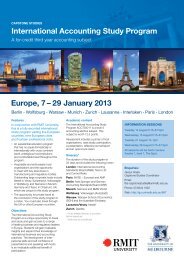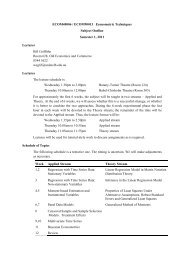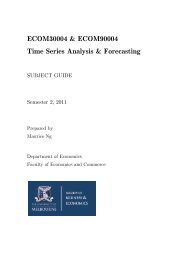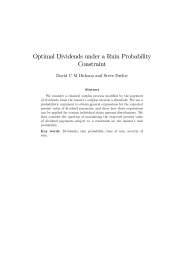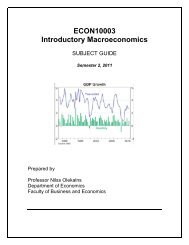A Model of Optimal Corporate Bailouts - Faculty of Business and ...
A Model of Optimal Corporate Bailouts - Faculty of Business and ...
A Model of Optimal Corporate Bailouts - Faculty of Business and ...
You also want an ePaper? Increase the reach of your titles
YUMPU automatically turns print PDFs into web optimized ePapers that Google loves.
government bails out the firm optimally, it already leaves existing owners with nothing. Any taxT 2 negatively distorts managerial effort, reduces the firm’s firm variable pr<strong>of</strong>its, <strong>and</strong> thereforerequires an even larger transfer payment to restart the firm. (If anything, the government wouldlike to impose a negative tax on revenues, thus rewarding firm owners more if the bailed outfirm succeeds. However, we do not allow for success-contingent subsidies.)This leaves only T 1 to fund any bailout. The tax-revenue it generates depends on managerialeffort at time 1, which depends on the managerial wages at time 1, which in turn depends onthe tax T 1 that the firm has to pay. The T ∗ above is the smallest possible self-funded tax that1ensures efficient continuation <strong>of</strong> distressed firms. Even there, however, as Theorem 2 notes,when I 2 is high it may simply be impossible to raise the required from tax revenues. Moreover,even if it were possible to do so, the firm may never afford that opportunity, because it neverinitially invests. All told, although Theorem 2 makes a case for redistributive bailouts, it alsosuggests that such bailouts should be utilized only sparingly. Finally, by insisting on the firing<strong>of</strong> the manager in case <strong>of</strong> a restart, there will be less need for bailouts, because the managerialmoral hazard will be lower. 19Analyzing the terms <strong>of</strong> the optimal tax rate yields the following:Corollary 1 The tax rate T ∗ financing an optimal non-zero bailout (when it exists) is decreasing1in the pay<strong>of</strong>f <strong>of</strong> a successful project (R), increasing in the manager’s effort cost (c), <strong>and</strong> increasingin the restart cost (I 2 ).As project revenues R grow, the firm owners become increasingly interested in reinvesting.Consequently, they do not need as much <strong>of</strong> a subsidy to restart, thereby allowing a lowertax rate. As the manager’s cost <strong>of</strong> effort c <strong>and</strong> the firm’s reinvestment costs grow, restartingbecomes less pr<strong>of</strong>itable to the firm, thereby necessitating a larger bailout <strong>and</strong> greater T 1 taxesto finance such.3.1 Graphical Illustration <strong>of</strong> Base <strong>Model</strong>We can illustrate the solutions with some examples. We normalize S = 1, <strong>and</strong> assume thatI 1 = 0 (e.g., the initial firm investment is minimal, or sunk long ago). The investment costI 2 = 0.1. Because we will consider revenues from R = 0 to R = 1, we choose the lowest cparameter that works for all R, which is c = R + S = 2.Figure 1 is the main figure <strong>of</strong> our paper. The black dash-dotted line is the first best outcome.Even if the project generates no revenues, the positive externalities mean that it would besocially worthwhile for managers to work. Unfortunately, this would require an unobtainableeffort level in the presence <strong>of</strong> managerial moral hazard that can only be remedied with asuccess-contingent salary.19 Although effort is only one example <strong>of</strong> moral hazard, our model intuition should readily extend to manysituation in which moral hazard creates other distortions (such as excessive risk-taking). By expropriatingmanagers in case <strong>of</strong> failure, moral hazard is lower.21



